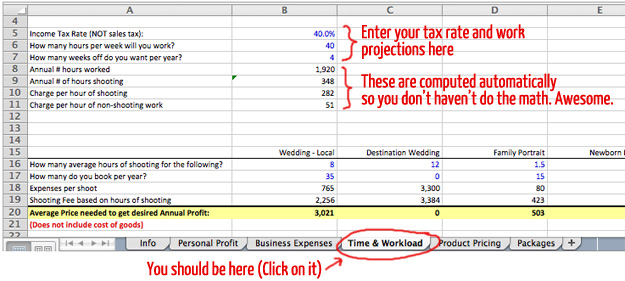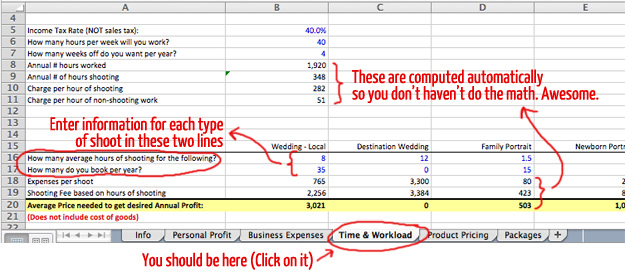
This post is Part 4 of The Modern Tog’s Photographer’s Pricing Guide series. Here’s the link to Part 1 of the Pricing Guide in case you missed it.
So now that you’ve determined how much profit you want to make and how much your expenses will be, it’s time to combine this with how many shoots you plan to do and see how much you need to be charging. If you’ve never done a pricing guide before, this is often the most shocking part for people. It’s also the most math-intensive, but no worries. If you really aren’t comfortable doing the math, you can always pick up the Pricing Guide Workbook and let it do the hard work for you.
Determine your tax rate and hours of work
You’ll need to talk to your accountant to find out what your tax rate is. In the United States, this is a variable rate based upon how much income you make, but to make things simple we’re going to look at your highest tax rate and apply that to everything. This model will work for any country where taxes are applied to whatever income is remaining after expenses have been accounted for.
Next you need to determine how much you want to work in a year in hours. To do this, take the number of hours you want to work each week times the number of weeks you want to work in a year. In the Photographer’s Pricing Guide Workbook you simply put the average number of hours you want to work per week and the number of weeks you want off as vacation and it will compute the number of hours worked in a year for you. You’ll find this on the “Time & Workload” tab at the bottom of the worksheet.

Calculate your total shooting hours per year
While there are many benefits to having a niche photography business where you only shoot one specific thing (such as weddings or pets or babies, but not all of them), most people will shoot just about anything that comes their way in the first few years of business in order make more money.
Most pricing guides look only at portraits or weddings and do not mix the two. I’ve designed this guide with the flexibility to incorporate up to 10 different types of shoots based upon the amount of time you are actually shooting each of them.
Look back at the list you made of the different types of expenses for each type of shoot. For each type you listed, estimate how many you plan to shoot in a year and how many hours on average you spend shooting per shoot. If you’re not sure what to put here, it’s better to under-estimate because then if you do more than that, you’ll simply have more profit. If you over-estimate, then you’ll end up with less profit in the end because you won’t have shot enough.
If you’re using the Photographer’s Pricing Guide Workbook, on the “Time & Workload” tab you will see the types of shoots listed automatically in row 15, and you’ll simply need to enter this information in rows 16 and 17 and the rest will calculate automatically. You can see your Total Shooting Hours in cell B9, and you can skip down to the “How much you need to charge” section as the next several parts are also calculated for you automatically.

For those of you doing this by hand, let’s look at an example. Let’s pretend that you plan to shoot 20 weddings averaging 8 hours of coverage each and 40 portraits averaging 1 hour each during the year.
We need to come up with the total number of hours you’ll be shooting for the year. So we’ll multiply the number of hours per shoot times the number of shoots you plan to do for each group and then add them all up. So in our example above, we’d have the following:
Weddings: 20 x 8 hours = 160 hours
Portraits: 40 x 1 hour = 40 hours
Total: 160 + 40 = 200 Total Shooting Hours per Year
Calculate your hourly shooting rate
Now we need to calculate how much you need to charge per hour of shooting, taking into account your desired profit, your expenses, your tax rate, and how many hours you’ll be shooting in the year.
Your hourly shooting rate is calculated using the following formula:

Looks scary, but it isn’t too bad when you break it down. Here’s the steps in order:
1. Change your tax rate percentage into decimal form by dividing by 100. So if you have a 40% tax rate, you’d get .40
2. Subtract this from 1. Here we’d get 1-.40 = .60
3. Take your total desired profit and divide it by the answer in step 2. So if you want to make $12,000 a year in profit, you’d take $12,000 divided by .60 and get $20,000.
4. Add on your total fixed expenses to the amount in step 3. So if you have $10,000 in total fixed expenses, you’d add this to $20,000 and get $30,000.
5. Divide the amount in step 4 by your total shooting hours per year. For example, we’d take $30,000 divided by 200 and our hourly shooting rate is $150.
See, that wasn’t so bad despite the scary formula.
Or, if you have the Photographer’s Pricing Guide Workbook you can simply look at cell B10 on the “Time & Workload” tab and see what your hourly rate is without doing any math.
Calculate your non-shooting hourly rate
While we won’t use this rate in pricing your different types of sessions, we will use this in helping us to price the products you offer to your clients. Basically, we’re taking the formula above and dividing it by your total hours of work per year instead of total shooting hours of work per year. So take the amount in step 4 and divide by your total hours of work per year. This is your non-shooting hourly rate.
How much you need to make
Okay, time to put these pieces together to figure out what you need to average for each type of shoot that you do.
For each type of shoot, take the number of hours of shooting (for one shoot) and multiply this times your hourly rate. Then add on the variable expenses you have for that shoot. This is how much you need to make on average for each type of shoot in order to meet your profit goals for the year before cost of goods. This is not just a session base fee; this includes anything you sell after subtracting out the cost of goods of the things you sell after the session (variable expenses are NOT considered cost of goods in this case, though.) We’ll look at how to get to this number when we discuss how to create packages in Part 6 of the pricing guide, so don’t worry about it too much right now.
If you are using the Photographer’s Pricing Guide Workbook, this is automatically computed in row 20 for each type of shoot.
If you’ve never done a pricing guide before, this number may seem shockingly high. This is why offering portrait sessions for $100 including a disc of digital negatives or $1000 wedding packages are not sustainable business models.
To make this number lower, you can lower the amount of profit you hope to make, shoot more sessions, or find a way to lower your expenses. If you feel that the balance between portraits and weddings is off, you can tweak this by adjusting the average amount of shooting time you spend per shoot to even it out. For example, if your portrait price is high and your wedding price is low, you’d lower the time it takes to shoot portraits or increase the time it takes to shoot a wedding. Because the hours are simply a way to allocate how much you need to make on each type of shoot, changing these numbers slightly will not change the overall total. Only the mix between the different types of shoots will be adjusted.
In the next few posts, we’ll be looking at how to price the various products you offer, how to create packages, and finally we’ll discuss how your market will affect your pricing.
Questions? Leave a comment below and we’ll answer for everyone’s benefit.

